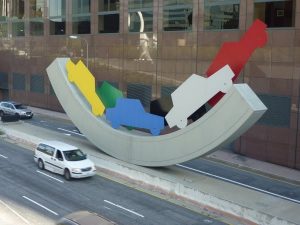The initial reaction: Upon seeing Lloyd Hamrol Log Ramps Sculpture. The first initial reaction of the ramps was the feeling of tranquility, I always see people around it usually studying, conversing or just relaxing. It is a place where people can go and take a break from the crazy world that is going on around you. You can get a different perspective on the world because of how it is going vertical towards the sky. The whole sculpture creates an atmosphere that makes you feel like you are in the forest sitting on top of a mountain because of how much vegetation surrounds the sculpture. There is always green grass, trees that obstruct your view from looking in certain directions. All the mediums that he use are all distinct in the Pacific Northwest. Instead of always looking up at the trees we are now able to sit on top of them and be a part of them, possibly to give us a chance to see things from a tree’s point of view. It emits a peaceful energy. The sculpture is located in a high activity area on campus which is why he wanted it to be a place where people can go off the beaten path and take a breather to recenter yourself. A chance to get out of the crazy, stressful world and go to a place that has natural features of the earth. The four log ramps form together to one point which can resemble a mountain and mountains are a place where you can go and be a part of something bigger than yourself which is exactly what Lloyd was trying to do, this sculpture is a place of peace.
About the Sculpture:
– Made 1974 and then rebuilt 1983
– (8.6′ h. x 40′ w) – Created with Douglas fir and wire cables
–The location was selected because it was by the environmental science building, and the artist intended his work to have a connection to nature.
-Anchored in ground by concrete caissons
About the artist: Lloyd Hamrol was born 1937 in CA and still lives there. He has won several awards as follows: 1993 Miller Award, Friends of the Junior Arts Center, Los Angeles, 1991 La Napoule Art Foundation, France, Artist Residency, 1990, 1980 and 1974 NEA, Artist Fellowship Grant.He recently had his Solo Exhibition at Thomas Paul Fine Art in 2015 which involved felt sculptures. Lloyd Hamrol’s exhibition “A sky in the palm of the hand” features large-scale felt sculptures. He works with Periman through over 30 site-specific public works to embrace landscapes and look further into the complex relationship between culture and nature.
Other works Lloyd Hamrol is known for: -The Uptown Rocker, made 1986, is currently located 4th St at Grand Ave LA and made of painted steel.
-The Roxhole is also in Los Angeles made 1979 from mortared stone.
conclusion: Lloyd Hamrol’s Log Ramp Sculpture is a place where students can go and disconnect from the crazy hectic world that is always happening around us. The sculpture demands peace from the viewer because you are interacting with organic elements in nature. This sculpture is a well-known sculpture around campus because of how beautiful it is but I have noticed that just because everyone knows about it does not mean that everyone stops and actually experiences the sculpture for themselves. We made this video to show how incredible the sculpture truly is. Lloyd Hamrol made his mark on campus in a way that is more important than being informative, it’s a place of relaxation.
credits: Rachel Semon- created the video with imovie, found the other works of art by Lloyd
Ursula Andrén- helped curate the idea of the video, found the history of the log ramps
Emily Hill- Recorded the video, posted blog onto website, found facts about the sculpture
citations: Hamrol, L. “about” Lloyd Hamrol Sculpture, http://www.lloydhamrol.com/about. 2015, accessed Oct 20, 2017 Editorial, Artsy, and Julie Baumgardner. “The Most Iconic Artists of the 1970s.” Artsy. N.p., 11 Aug. 2015. “Western Gallery.” Western Gallery. N.p., n.d. Web. 20 Oct. 2017. React. Research. Execute! (n.d.). Retrieved October 25, 2017, from https://wp.wwu.edu/wwuart109/2016/11/14/johnny-phan-elisabeth-minor-and-donna-ganb aatar-log-ramp-by-lloyd-hamrol/ Andrews, O. (1983). Living materials: a sculptor’s handbook . Berkeley u.a.: Univ. of California Pr. Robertson, J., & McDaniel, C. (2017). Themes of contemporary art: visual art after 1980 . New York: Oxford University Press.


Leave a Reply